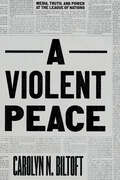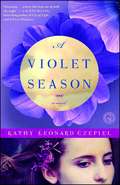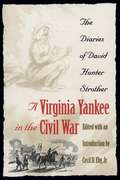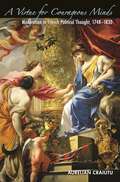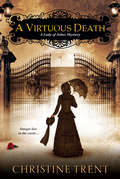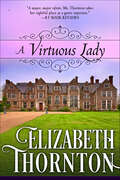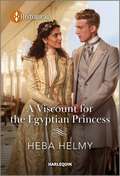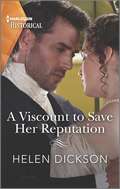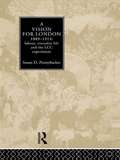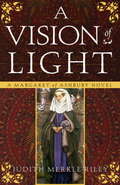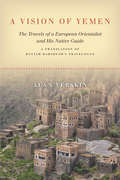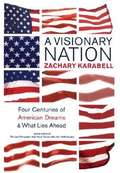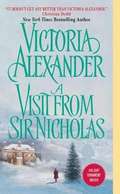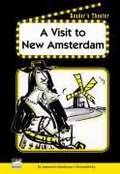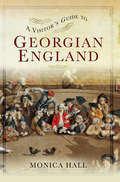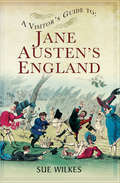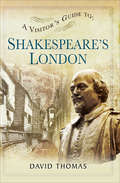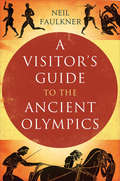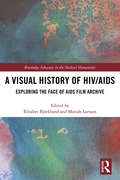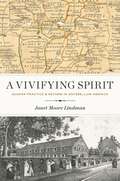- Table View
- List View
A Violent Peace: Media, Truth, and Power at the League of Nations
by Carolyn N. BiltoftThe newly born League of Nations confronted the post-WWI world—from growing stateless populations to the resurgence of right-wing movements—by aiming to create a transnational, cosmopolitan dialogue on justice. As part of these efforts, a veritable army of League personnel set out to shape “global public opinion,” in favor of the postwar liberal international order. Combining the tools of global intellectual history and cultural history, A Violent Peace reopens the archives of the League to reveal surprising links between the political use of modern information systems and the rise of mass violence in the interwar world. Historian Carolyn N. Biltoft shows how conflicts over truth and power that played out at the League of Nations offer broad insights into the nature of totalitarian regimes and their use of media flows to demonize a whole range of “others.” An exploration of instability in information systems, the allure of fascism, and the contradictions at the heart of a global modernity, A Violent Peace paints a rich portrait of the emergence of the age of information—and all its attendant problems.
A Violet Season
by Kathy L CzepielA MOTHER'S CHOICES IN A T IME OF CRISIS THREATEN THE ONE PERSON SHE MEANS TO PROTECT--HER ONLY DAUGHTER-- AND FORCE HER TO MAKE THE BOLDEST MOVE OF HER LIFE. The violet industry is booming in 1898, and a Hudson Valley farm owned by the Fletcher family is turning a generous profit for its two oldest brothers. But Ida Fletcher, married to the black sheep youngest brother, has taken up wet nursing to help pay the bills, and her daughter, Alice, has left school to work. As they risk losing their share of the farm, the two women make increasingly great sacrifices for their family's survival, sacrifices that will set them against each other in a lifelong struggle for honesty and forgiveness. A Violet Season is the story of an unforgettable mother-daughter journey in a time when women were just waking to their own power and independence.
A Virginia Yankee in the Civil War
by Cecil D. EbyThe Civil War diaries of David Hunter Strother, known better to his contemporaries as "Porte Crayon," chronicle his three years of service in the Union army with the same cogency and eye for detail that made him one of the most popular writers and illustrators in America in his time. A Virginian strongly opposed to secession, Strother joined the Federal army as a civilian topographer in July of 1861 and was soon commissioned, rising eventually to the rank of brigadier general. He served under a succession of commanders, including Generals Patterson, Banks, Pope, and McClellan, winning their respect as well as their confidence. First published by UNC Press in 1961, A Virginia Yankee in the Civil War is a fascinating firsthand record of the conflict and of the divided loyalties it produced that is further enlivened by Strother's remarkable humor and insight.
A Virtue for Courageous Minds: Moderation in French Political Thought, 1748-1830
by Aurelian CraiutuPolitical moderation is the touchstone of democracy, which could not function without compromise and bargaining, yet it is one of the most understudied concepts in political theory. How can we explain this striking paradox? Why do we often underestimate the virtue of moderation? Seeking to answer these questions, A Virtue for Courageous Minds examines moderation in modern French political thought and sheds light on the French Revolution and its legacy. Aurelian Craiutu begins with classical thinkers who extolled the virtues of a moderate approach to politics, such as Aristotle and Cicero. He then shows how Montesquieu inaugurated the modern rebirth of this tradition by laying the intellectual foundations for moderate government. Craiutu looks at important figures such as Jacques Necker, Madame de Staël, and Benjamin Constant, not only in the context of revolutionary France but throughout Europe. He traces how moderation evolves from an individual moral virtue into a set of institutional arrangements calculated to protect individual liberty, and he explores the deep affinity between political moderation and constitutional complexity. Craiutu demonstrates how moderation navigates between political extremes, and he challenges the common notion that moderation is an essentially conservative virtue, stressing instead its eclectic nature. Drawing on a broad range of writings in political theory, the history of political thought, philosophy, and law, A Virtue for Courageous Minds reveals how the virtue of political moderation can address the profound complexities of the world today.
A Virtuous Death (A Lady of Ashes Mystery #3)
by Christine TrentUndertaker Violet Harper confronts the dire predictions of a fortuneteller in Queen Victoria&’s court in this gripping tale by the author of Stolen Remains.Queen Victoria, still mourning her long-dead husband Prince Albert, has found solace in John Brown, an enigmatic palace servant who dabbles in the occult and keeps the grieving queen entertained with his tarot card readings. Undertaker Violet Harper is invited to attend one of Mr. Brown&’s infamous readings, during which he implies that Buckingham Palace will soon be shrouded in death&’s dark veil. Well acquainted with death, Violet shrugs him off as a charlatan—until his sinister divinations begin to prove true . . .Violet wonders if something foul is in the cards when the aristocratic young friends of the queen&’s daughter begin to die under mysterious circumstances. Her suspicions only grow when one of London&’s &“moralists,&” a group bent on repealing the law that forces prostitutes into hospitals, suffers a similar fate. The deaths merely buttress the queen&’s enthusiasm for Mr. Brown&’s ominous talents, and, concerned by the fortuneteller&’s influence, Violet races against time to unearth the truth before the killer strikes again. But as she closes in on a murderer with an unearthly motive, Violet realizes she may be digging her own grave . . .Praise for the Lady of Ashes series&“Violet remains an engaging guide with an unusual perspective on Victorian society.&” —Publishers Weekly&“Filled with informative historical tidbits on some of the less salubrious aspects of Victorian times and plenty of red herrings.&” —Kirkus Reviews &“A book you can sink your teeth into, with characters you&’ll fall in love with.&” —Mystery Scene
A Virtuous Lady
by Elizabeth ThorntonFrom the USA TODAY bestselling author."I consider Elizabeth Thornton a major find." —Mary Balogh, NEW YORK TIMES bestselling author of ONLY ENCHANTINGBriony Langland had no use for the superficial games of the ton. She did, however, have choice words for London's most notorious rake when she caught him dallying with his flavor of the moment in her uncle's library. She never thought that her bold set-down would only inspire his lordship to employ his considerable charms to awaken her own deepest passions.Hugh Montgomery, Marques of Ravensworth, has never met a woman he couldn't seduce and just as easily forget. But Briony, so self-possessed, so scrupulous, so determined to thwart him at every turn, has awakened something deep inside his cold, self-serving heart—a desire to experience love. His lordship has a few lessons to learn in the art of sweet persuasion...and Briony may be just the woman to teach him.
A Viscount for the Egyptian Princess
by Heba HelmyEscape to 1870s Egypt and explore the royal court with this spellbinding romance…An unforgettable meeting in ParisAn unexpected reunion in Egypt Viscount Louis Wesley is captivated by the beautiful woman he meets at the Louvre. He never expects to see her again, but then he arrives in Egypt for his royal best friend&’s wedding and discovers she&’s the bride, Princess Mervat! Learning it&’s a convenient match that both intend to avoid, Louis vows to help. The stakes may be high, but Louis&’s biggest challenge will be resisting falling for the princess himself!From Harlequin Historical: Your romantic escape to the past.
A Viscount to Save Her Reputation
by Helen DicksonThe makings of a scandal…Or a marriage?Escaping from a marriage she doesn’t want, heiress Lucy Walsh falls straight into the arms of Christopher Wilding, Viscount Rockley—causing a scandal! Lucy’s drawn to the enigmatic viscount, but he seems to think he’s too cynical and mature for her. While she’s under his protection, the ton will gossip, and with her godmother on her way to fetch her, Lucy is running out of options to save her reputation—and her heart!From Harlequin Historical: Your romantic escape to the past.
A Vision for London, 1889-1914: labour, everyday life and the LCC experiment
by Susan D. PennybackerThe London County Council was a the world's largest municipal government and a laboratory for social experimentation before the Great War. It sought to master the problems of metropolitan amelioration, political economy and public culture. Pennybacker's social history tests the vision of London Progressivism against its practitioners' accomplishments. She argues that the historical memory of the hopes inspired by LCC achievement and the disillusions spawned by failure, are potent forces in today's deeply ambivalent responses to metropolitan politics in London. The `new women', bohemian London, scandal in the building industry, midwifery, lodging houses, children's provision and the music hall were all provocative issues in LCC work. Their story richly evokes life in the turn-of-the-century metropolis and illustrates the complexities of `municipal socialism'.
A Vision of Light
by Judith Merkle RileyThe bestselling novel that introduces Margaret of Ashbury and launches a trilogy featuring this irrepressible woman Margaret of Ashbury wants to write her life story. However, like most women in fourteenth-century England, she is illiterate. Three clerics contemptuously decline to be Margaret’s scribe, and only the threat of starvation persuades Brother Gregory, a Carthusian friar with a mysterious past, to take on the task. As she narrates her life, we discover a woman of startling resourcefulness. Married off at the age of fourteen to a merchant reputed to be the Devil himself, Margaret was left for dead during the Black Plague. Incredibly, she survived, was apprenticed to an herbalist, and became a midwife. But most astonishing of all, Margaret has experienced a Mystic Union—a Vision of Light that endows her with the miraculous gift of healing. Because of this ability, Margaret has become suddenly different—to her tradition-bound parents, to the bishop’s court that tries her for heresy, and ultimately to the man who falls in love with her. From the Trade Paperback edition.
A Vision of Light: A Margaret of Ashbury Novel
by Judith Merkle RileyThe bestselling novel that introduces Margaret of Ashbury and launches a trilogy featuring this irrepressible womanMargaret of Ashbury wants to write her life story. However, like most women in fourteenth-century England, she is illiterate. Three clerics contemptuously decline to be Margaret's scribe, and only the threat of starvation persuades Brother Gregory, a Carthusian friar with a mysterious past, to take on the task. As she narrates her life, we discover a woman of startling resourcefulness. Married off at the age of fourteen to a merchant reputed to be the Devil himself, Margaret was left for dead during the Black Plague. Incredibly, she survived, was apprenticed to an herbalist, and became a midwife. But most astonishing of all, Margaret has experienced a Mystic Union--a Vision of Light that endows her with the miraculous gift of healing. Because of this ability, Margaret has become suddenly different--to her tradition-bound parents, to the bishop's court that tries her for heresy, and ultimately to the man who falls in love with her.From the Trade Paperback edition.
A Vision of Yemen: The Travels of a European Orientalist and His Native Guide, A Translation of Hayyim Habshush's Travelogue
by Alan VerskinIn 1869, Hayyim Habshush, a Yemeni Jew, accompanied the European orientalist Joseph Halévy on his archaeological tour of Yemen. Twenty years later, Habshush wrote A Vision of Yemen, a memoir of their travels, that provides a vivid account of daily life, religion, and politics. More than a simple travelogue, it is a work of trickster-tales, thick anthropological descriptions, and reflections on Jewish–Muslim relations. At its heart lies the fractious and intimate relationship between the Yemeni coppersmith and the "enlightened" European scholar and the collision between the cultures each represents. The book thus offers a powerful indigenous response to European Orientalism. This edition is the first English translation of Habshush's writings from the original Judeo-Arabic and Hebrew and includes an accessible historical introduction to the work. The translation maintains Habshush's gripping style and rich portrayal of the diverse communities and cultures of Yemen, offering a potent mixture of artful storytelling and cultural criticism, suffused with humor and empathy. Habshush writes about the daily lives of men and women, rich and poor, Jewish and Muslim, during a turbulent period of war and both Ottoman and European imperialist encroachment. With this translation, Alan Verskin recovers the lost voice of a man passionately committed to his land and people.
A Visionary Nation: Four Centuries of American Dreams and What Lies Ahead
by Zachary KarabellIn this penetrating volume, Zachary Karabell examines the continuous thread that runs through the tapestry of the American experience -- the belief that we can create a perfect society -- and envisions what the next great era will be. Just as the Puritan vision of a city on a hill was supplanted by the Founding Fathers' vision of individuality, just as the expansive vision of a government-led Great Society was eclipsed by the New Economy of the 1990s, so too is the New Economy being replaced by what Karabell contends will be a period when community and spirituality occupy center stage.
A Visit from Sir Nicholas (Effington Family #9)
by Victoria AlexanderEveryone knows that an Effington always getsher way ... but this time it's not going to be easy! Lady Elizabeth Effington simply could not suitably feel the joy of the Christmas season. Ten years had passed since she had boldly declared her love for Sir Nicholas Collingsworth. He rebuffed her and set out to seek his fortunes, while Elizabeth was left a woman scorned. Now, she discovers in horror that the inheritance she's managed beautifully was never hers to control. No, power over her finances lay in the hands of the last man she ever wants to see again: Nicholas! But running Elizabeth's life isn't part of Nick's plans. He's intrigued when he discovers that the frivolous and flighty girl he once knew has turned into a beautiful and capable woman. Nick vows to woo -- and win -- her, and while she seems unmoved by his fervent seduction, he swears he will not rest until she accepts that most precious gift of all -- the gift of love.
A Visit to New Amsterdam
by Jeannette Sanderson Karen Leon Jeffrey FuerstPerform this script about two children who travel back in time to explore what New York City was like in 1647.
A Visit to Three Fronts June 1916: June 1916 (world Classics, Unabridged) (The World At War)
by Arthur DoyleThe book is a glorious effort on the part of the author to record the impressions that he formed during his visit to the fronts of the Western Allies during World War I. The book was written in appreciation of the valiant and bold soldiers who fought for their countrymen and whose efforts were being belittled due to increasing rumours. (Excerpt from Goodreads)
A Visitor's Guide to Georgian England
by Monica HallCould you successfully be a Georgian? Find yourself immersed in the pivotal world of Georgian England, exciting times to live in as everything was booming; the Industrial Revolution, the Enlightenment, and the nascent Empire; inhabited by Mary Shelley, the Romantic Poets and their contemporaries. However, rather than just wondering about the famous or infamous, you will find everything you need to know in order to survive undetected among the ordinary people. What to wear, how to behave yourself in public, earn a living, and find somewhere to live. Very importantly, you will be given advice on how to stay on the right side of the law, and how to avoid getting seriously ill. Monica Hall creatively awakens this bygone era, filling the pages with all aspects of daily life within the period, calling upon diaries, illustrations, letters, poetry, prose, 18th century laws and archives. This detailed account intimately explores the ever changing lives of those who lived through Britains imperial prowess, the birth of modern capitalism, the reverence of the industrial revolution and the upheaval of great political reform and class division. A Visitors Guide to Georgian England will appeal to Romantic poetry lovers, social history fans, fiction and drama lovers, students and anyone with an interest in this revolutionary era.
A Visitor's Guide to Jane Austen's England (A Visitor's Guide #2)
by Sue Wilkes&“Wilkes makes the world of Jane Austen come to life . . . from travel to fashion, shopping, leisure, and, of course, finding a mate&” (Britain Express). Immerse yourself in the vanished world inhabited by Austen&’s contemporaries. Packed with detail and anecdotes, this is an intimate exploration of how the middle and upper classes lived from 1775, the year of Austen&’s birth, to the coronation of George IV in 1820. Sue Wilkes skillfully conjures up all aspects of daily life within the period, drawing on contemporary diaries, illustrations, letters, novels, travel literature, and archives. Were all unmarried affluent men really &“in want of a wife&”?Where would a young lady seek adventure?Would &“taking the waters&” at Bath and other spas kill or cure you?Was Lizzy Bennet bitten by bed-bugs while traveling?What would you wear to a country ball or a dance at Almack&’s?Would Mr. Darcy have worn a corset?What hidden horrors lurked in elegant Regency houses? &“A delight. I don&’t think I&’ve ever read a book that paints such a vivid picture of daily life in late 18th and early 19th century England. It makes a perfect companion for Austen&’s beloved novels.&” —The Heritage Traveller &“A thoroughly engaging—and very informative—&‘eyewitness&’ guide to everything from medical matters to modes of travel.&” —Joceline Bury, Jane Austen&’s Regency World &“Written as if to a first-time traveler in the Regency . . . an inviting read . . . a perfect gift for every Janeite friend and family member.&” —Austenprose &“A worthy contribution to the field of Austen social history and uses the mundane realities of life to illuminate the reader&’s experience.&” —Sensibilities
A Visitor's Guide to Mystic Falls: Your Favorite Authors on The Vampire Diaries
by Red VeeThe Vampire Diaries, the television series based on the iconic books by L.J. Smith, has already managed to captivate millions of viewers with its unique mix of immortal romance and very human drama. In A Visitor's Guide to Mystic Falls, YA authors—led by Red and Vee of premier Vampire Diaries resource Vampire-Diaries.net—take a closer look at Mystic Falls: its residents (both alive and undead) and its rich, inescapable history. Claudia Gray delves into the events of 1864 and how they've shaped not just Mystic Falls but the success of the show itself Sarah Rees Brennan tells us what it takes for a girl to hold her own against a vampire boyfriend (or two), placing Elena squarely between fellow vampire-daters Buffy and Bella Jennifer Lynn Barnes takes Mystic Falls to task for poor treatment of Caroline Forbes Jon Skovron examines the male-female vampire dynamic, in history and in The Vampire Diaries Plus a guide to the book series for tv fans looking to visit The Vampire Diaries' literary inspiration, and more Whether you're a new visitor or a long-time fan, you won't want to continue your tour of Mystic Falls without it.
A Visitor's Guide to Shakespeare's London (A Visitor's Guide #3)
by David ThomasA fresh and colorful look at Shakespeare&’s London published on the 400th anniversary of the playwright&’s death. In A Visitor&’s Guide to Shakespeare&’s London, readers can explore the streets of Shakespeare&’s London and see the sights he saw, while learning how people ate, drank, misbehaved, and had fun. You will discover what it was like to be a tourist in the sixteenth century from the voices of people who came to London during Shakespeare&’s day. You will travel with them to the major tourist sights and will learn how to get about, where to stay and what to eat and drink. You will visit the royal palaces, London&’s famous gardens, the Tower of London and Old St Paul&’s Cathedral. You will discover the pleasure of London&’s theaters, the sports people played and the shopping they enjoyed. As now, London was famous as a shopping destination. But beware, London is full of people who will pick your pockets or trick you out of your money and you are constantly at risk from the plague or even the polluted water supply. Most of the London Shakespeare knew has been destroyed by fire, war and developers, but a surprising number of buildings and places he knew still survive. The book contains guided tours that allow you to sample the atmosphere and see the sights Tudor tourists enjoyed. This title will appeal to Shakespeare lovers, social history fans, fiction and drama lovers, students, and anyone with an interest in this fascinating era of London&’s history.
A Visitor's Guide to Victorian England: Victorian England (A Visitor's Guide #1)
by Michelle HiggsAn &“utterly brilliant&” and deeply researched guide to the sights, smells, endless wonders, and profound changes of nineteenth century British history (Books Monthly, UK). Step into the past and experience the world of Victorian England, from clothing to cuisine, toilet arrangements to transport—and everything in between. A Visitor&’s Guide to Victorian England is &“a brilliant guided tour of Charles Dickens&’s and other eminent Victorian Englishmen&’s England, with insights into where and where not to go, what type of people you&’re likely to meet, and what sights and sounds to watch out for . . . Utterly brilliant!&” (Books Monthly, UK). Like going back in time, Higgs&’s book shows armchair travelers how to find the best seat on an omnibus, fasten a corset, deal with unwanted insects and vermin, get in and out of a vehicle while wearing a crinoline, and avoid catching an infectious disease. Drawing on a wide range of sources, this book blends accurate historical details with compelling stories to bring alive the fascinating details of Victorian daily life. It is a must-read for seasoned social history fans, costume drama lovers, history students, and anyone with an interest in the nineteenth century.
A Visitor's Guide to the Ancient Olympics
by Neil FaulknerThe essential handbook for the 21st-century citizen seeking a lively guided tour of the ancient Greek Olympics. Travel back to the heyday of the city-state and classical Greek civilization. Enter this distant, alien, but still familiar culture and discover what the Greeks did and didn&’t do during five thrilling days in August, 388 B.C.In the Olympic Stadium there were no stands, no shade—and no women allowed. Visitors sat on a grassy bank in the searing heat of midsummer to watch naked athletes compete in footraces, the pentathlon, horse and chariot races, and three combat sports—wrestling, boxing, and pankration, everyone's favorite competition, with virtually no rules and considerable blood and pain. This colorfully illustrated volume offers a complete tour of the Olympic site exactly as athletes and spectators found it. The book evokes the sights, sounds, and smells of the crowded encampment; introduces the various attendees (from champions and charlatans to aristocrats and prostitutes); and explains the numerous exotic religious rituals. Uniquely detailed and precise, this guide offers an unparalleled opportunity to travel in time, back to the excitement of ancient Olympia.&“Splendidly captures the excitement, the razzmatazz, the intensity, glamour and squalor of the ancient Olympics. Packed with anecdotes and intriguing facts, the careful scholarship behind this wonderful little book is presented with gusto.&”—Philip Matyszak, author of Ancient Athens on Five Drachmas a Day&“Ultimately the ancient Olympics were more of an epic frat party full of booze and sex than a prestigious sporting competition, and Faulkner paints that picture well.&”—Moira E. McLaughlin, The Washington Post
A Visual History of Caravans: Photographs from the 1920's to Modern Day
by Andrew JenkinsonThis book is a visual and informative look at the heritage of the touring caravan covering over a 100 years of this now very popular form of leisure. The book witnesses the UK being the inventor, developer and major producer of touring caravans. Images; (many from the Authors own personal archive) shows how caravan interior/exterior design has evolved and has been influenced by domestic trends through the decades. With nostalgic images the book brings to life this often forgotten yet important aspect of the modern touring caravan. Covering imported caravans as well as UK manufactured models shows just how continental tastes differ from UK buyers. The touring caravan is a modern and sophisticated leisure vehicle that has evolved since the first commercial built Eccles brand caravan back in 1919. A then rich mans hobby, it became more affordable by the 1930’s and this was made possible with more modern production techniques. The design of the caravan emerged from a basic box like profile influenced by the 1800’s horse drawn gypsy caravan that became a fashionable form of holiday with the gentry. Dr Gordon Stables a retired Naval Officer influenced this idea with his specially built horse drawn caravan “The Wanderer” – now on show at the Broadway Caravan & Motorhome Club Site. Stables wrote of his adventures and caravanning in a sense had begun. The book contains many unpublished and rare images which also features cars from the period too. Andrew writes for Practical Motorhome, Practical Caravan and Park Home and Holiday Caravan Magazine among others and attends all major related shows.
A Visual History of HIV/AIDS: Exploring The Face of AIDS film archive (Routledge Advances in the Medical Humanities)
by Elisabet Björklund Mariah LarssonThe Face of AIDS film archive at Karolinska Institutet, Sweden, consists of more than 700 hours of unedited and edited footage, shot over a period of more than thirty years and all over the world by filmmaker and journalist Staffan Hildebrand. The material documents the HIV/AIDS pandemic and includes scenes from conferences and rallies, and interviews with activists, physicians, people with the infection, and researchers. It represents a global historical development from the early years of the AIDS crisis to a situation in which it is possible to live a normal life with the HIV virus. This volume brings together a range of academic perspectives – from media and film studies, medical history, gender studies, history, and cultural studies – to bear on the archive, shedding light on memories, discourses, trauma, and activism. Using a medical humanities framework, the editors explore the influence of historical representations of HIV/AIDS and stigma in a world where antiretroviral treatment has fundamentally altered the conditions under which many people diagnosed with HIV live. Organized into four sections, this book begins by introducing the archive and its role, setting it in a global context. The first part looks at methodological, legal and ethical issues around archiving memories of the present which are then used to construct histories of the past; something that can be particularly controversial when dealing with a socially stigmatized epidemic such as HIV/AIDS. The second section is devoted to analyses of particular films from the archive, looking at the portrayal of people living with HIV/AIDS, the narrative of HIV as a chronic illness and the contemporary context of particular films. The third section looks at how stigma and trauma are negotiated in the material in the Face of AIDS film archive, discussing ideas about suffering and culpability. The final section contributes perspectives on and by the filmmaker as activist and auteur. This interdisciplinary collection is placed at the intersection of medical humanities, sexuality studies and film and media studies, continuing a tradition of studies on the cultural and social understandings of HIV/AIDS.
A Vivifying Spirit: Quaker Practice and Reform in Antebellum America
by Janet Moore LindmanAmerican Quakerism changed dramatically in the antebellum era owing to both internal and external forces, including schism, industrialization, western migration, and reform activism. With the “Great Separation” of the 1820s and subsequent divisions during the 1840s and 1850s, new Quaker sects emerged. Some maintained the quietism of the previous era; others became more austere; still others were heavily influenced by American evangelicalism and integration into modern culture. Examining this increasing complexity and highlighting a vital religiosity driven by deeply held convictions, Janet Moore Lindman focuses on the Friends of the mid-Atlantic and the Delaware Valley to explore how Friends’ piety affected their actions—not only in the evolution of religious practice and belief but also in response to a changing social and political context. Her analysis demonstrates how these Friends’ practical approach to piety embodied spiritual ideals that reformulated their religion and aided their participation in a burgeoning American republic.Based on extensive archival research, this book sheds new light on both the evolution of Quaker spiritual practice and the history of antebellum reform movements. It will be of interest to scholars and students of early American history, religious studies, and Quaker studies as well as general readers interested in the history of the Society of Friends.
